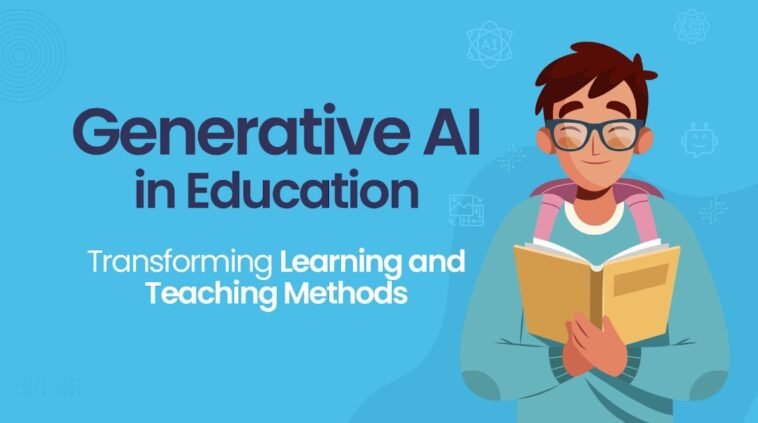Nowadays, generative AI, a form of artificial intelligence, is influencing many kinds of areas, including education. Generative AI (Gen-AI) has the potential to transform teaching and learning processes by customizing training for students. It does this by examining a student’s learning style, preferences, formal material, learning tactics, and feedback skills.
Read the blog to learn how Generative AI is shaping the future of learning and education.
What is generative AI?
Generative AI (artificial intelligence) creates artistic output such as novels, music, paintings, and even a completely virtual world. Machine learning and other AI technologies often use data patterns to predict or categorize, but generative AI creates wholly new content from visible patterns in datasets. This method sets it apart from normal AI technology.
Must Read: Ultimate Website Maintenance Checklist
How does generative AI work?
Generative AI uses sophisticated algorithms to generate new information. This may include a variety of approaches such as neural networks, probabilistic models and reinforcement learning. Popular generative AI models include GANs (Generative Adversarial Networks), which pit two neural networks against one another to produce realistic material, as well as language models such as GPT (Generative Pre-trained Transformer), which can generate coherent text in response to a certain stimulus.
The Evolution of Generative AI in Education
Advances in generative AI in education have the potential to significantly impact future learning experiences and teaching approaches. Predictably, developments in AI technology will result in increasingly complicated, personalized learning experiences, with AI-powered tutors providing real-time feedback and adaptive lessons suited to each student’s specific requirements.
Incorporating augmented reality (AR) and virtual reality (VR) into educational environments allows educators to create immersive learning experiences that engage and comprehend students. AI-powered tools may boost creativity by generating artwork, music, and writing recommendations, allowing students to put their ideas into action and express themselves in novel ways. Generative AI improves language learning by providing virtual teachers and translation tools, which make it more interesting and accessible.
Must Read: AI-Generated Responsive Web Design
Enhancing Teacher and Student Interactions with AI Tools
AI tools like ChatGPT and chatbots are being seamlessly integrated into classrooms to support lesson planning and content creation. Teachers may use these AI-powered assistants to develop lesson ideas, create compelling content, and offer immediate feedback to students.
Chatbots can also act as virtual instructors, answering students’ queries and helping them through learning materials outside of class time. By automating repetitive activities and providing individualized support, artificial intelligence technologies improve teacher efficiency and allow meaningful interactions between educators and students, resulting in a collaborative and dynamic learning environment.
Some ways in which generative AI can change education
Personalized Learning Experiences
Generative AI enables the creation of learning materials tailored to each student’s needs and learning styles. AI algorithms may generate individualized courses, quizzes, and exercises based on student data and preferences, addressing each learner’s strengths and weaknesses.
Must Read: Design a Government Website
Enhanced Creativity
Generative AI systems foster creativity by creating art, music, and textual recommendations. AI-generated content enables students to realize their creative potential by fostering curiosity and innovation in various areas, from literature to visual arts.
Language Learning Support
AI-powered language tutors and translation tools make language learning easier by offering interactive courses, real-time feedback, and immersive language practice. Generative AI allows for the production of language workouts, quizzes, and conversation simulations to improve language learning abilities.
Automated administration chores
Generative AI simplifies administrative tasks such as grading assignments, developing curriculum, and organizing teaching materials. Teachers may focus on personalized instructions and student engagement by automating routine tasks.
Supporting Special Education
AI-powered technology can analyze student data, identify individual strengths and weaknesses, and offer personalized learning experiences based on specific learning disabilities or preferences.Generative AI supports the creation of accessible content such as Braille textbooks, audio lectures and scripted movies. It provides equal access to educational resources and opportunities for all students.
Must Read: OSHA Training
Real-time Feedback and Evaluation
Generative AI systems can provide student feedback, grade assignments, and personalized feedback to help measure learning outcomes. Generative AI systems may track student responses to improve learning outcomes.
Virtual Learning Environments
Generative AI enables immersive virtual learning environments that closely match real-world programming and interaction. Gen AI provides AR and VR applications that support experiential and immersive learning. Students can use virtual environments, virtual experiments, and simulated objects to increase their understanding of abstract concepts.
Addressing Concerns and Ethical Considerations
Privacy and Data Security
To prevent unwanted access to data, robust encryption and access restrictions must be used. It fosters openness and confidence among students and parents while ensuring adherence to privacy requirements such as GDPR (The General Data Protection Regulation) and COPPA (The Children’s Online Privacy Protection Act).
Must Read: Google Gemini AI
Bias and Fairness
Large training datasets and rigorous evaluation procedures can aid in identifying and correcting biases in AI algorithms. Furthermore, the adoption of a transparent and accountable decision-making process assures that AI programs are sound and appropriate.
Maintaining Human Touch
Artificial intelligence (AI) can improve teaching techniques and learning experiences, but it is not intended to replace instructors. Two ways to introduce AI into the classroom include collaborative learning environments and continuous professional development for instructors. The emphasis is also on human-centred components of education, such as empathy, creativity, and critical thinking.
Ethical Use of AI
To ensure that AI is used ethically in education, clear norms and criteria for AI technology development and implementation must be established. Educators and politicians must examine the societal implications of AI in education, such as fairness, accessibility, and accountability.
Continuous Monitoring and Evaluation
Educators and administrators should conduct frequent assessments of AI technologies’ influence on teaching and learning results, as well as their implications for student well-being and engagement.
Collaboration between Educators and AI
- Embracing Collaboration: Collaboration is essential for successfully incorporating AI into education. They may collaborate with AI developers and academics to build AI solutions that address a wide range of educational objectives.
- Sharing Knowledge and Expertise: Collaboration refers to the exchange of information and expertise between educators and AI stakeholders. Educators understand student requirements, while AI developers contribute technical competence, resulting in more effective and impactful AI-powered educational interventions.
- Continuous Improvement: Collaboration enables the continual enhancement of AI-powered instructional products. Educators and AI stakeholders enhance solutions to better fit the changing demands of education, eventually improving teaching effectiveness and student learning results.
Conclusion
Generative AI has the potential to transform education by increasing learning results, automating processes, and encouraging diversity. However, it must address concerns like privacy, bias, and maintaining human contact. We can realize the full potential of Generative AI by collaborating as educators, researchers, and AI developers to create a more engaging, equitable, and successful learning environment for all students.
Author Bio
Rachna Namjoshi is an SEO Executive at TechForce Services/TechForce Academy. She seamlessly blends her expertise in SEO strategies with her flair for compelling content creation. Her passion for continuous learning and unbridled curiosity drive her to stay at the forefront of the latest developments and technologies.





